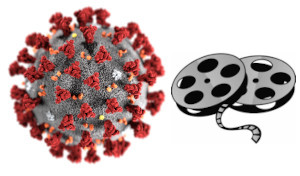Just when you think another large-scale disaster could not possibly happen, think again.
The year 2020 was supposed to be a special year. Think about it. It's the start of a new decade, in a year containing two alternating digits that could also signify clear vision and, therefore, be a metaphor for greater clarity about our own lives. I cannot think of another year that would be as symbolic. Sadly, this one opportunity for a great symbolic year has been destroyed, thanks in part to a novel coronavirus disease first observed in 2019, what the World Health Organization now officially calls COVID-19. The notion of infectious diseases and epidemics isn't exactly foreign to us, but we seldom think about worldwide pandemics becoming a reality in our lifetime. Even the global existence of HIV and AIDS hasn't exactly put many people on alert in the 21st century.
The fallout of the COVID-19 pandemic is undeniably huge, in both medical and economic terms. The disease has disrupted or decimated human lives, everyday activities, and businesses. The entertainment industry is no exception. If anything, the widespread interruption of major sources of leisure that we take for granted, like movies, television, music, and sports, has truly stunned people, even those who don't regularly follow current events. It's a real wake-up call about how nothing is 100% certain.
Like many of you out there, I have plenty of thoughts related to life during the COVID-19 pandemic. I would like to spend some time going down memory lane, looking back on this health crisis that, for most of us, is unprecedented because we've never lived through anything like it. This is not a fully contemporaneous account, as I began writing this in July 2021 and added updates periodically as time went on, but it will still brush over my experiences along with observations and events related to the entertainment industry. It may be depressing to look back on the lost year of 2020 and beyond, but sometimes, it takes a little courage to face the darkness in order to move on from it.
With that, let's start by going back to when all of this began.
December 2019 to February 2020
Early Warning Signs
In was December 2019 when the news media first announced that China was having an outbreak of a novel coronavirus. It appeared that this virus originated from a wet market in Wuhan, China. When I first heard about this, my initial thought was probably similar to many people. China had undergone a major disease outbreak before, with the SARS virus in 2003, and managed to get through that even if it did cause plenty of deaths. I thought this would be no different. The virus would eventually stop spreading and be fully contained within China's borders. Life would go on as always.
Around this time, I was really looking forward to 2020. Just the number itself already made the new year sound special, so I made a note to make it a year I wouldn't forget. For one thing, I was researching models of new cars, specifically hybrid vehicles, and worked to narrow my choices. I figured 2020 would be the perfect year to buy a new car. I also planned to take a big vacation in late March. Not too long after that decision, I went ahead and booked a hotel reservation, as well as purchase tickets for specific leisure activities I was planning. At one point, I was even thinking of making sure I would buy the new car first so that I would drive it to my vacation destination.
Meanwhile, the coronavirus situation was not getting better. In January 2020, cases of this novel coronavirus were detected outside China, including Thailand, France, and the United States. In my state of California, the first case was detected on January 26, 2020, in someone who had returned to the state from Wuhan, China. No longer was this disease a local epidemic. It was going around the world. But was it setting off mental alarm bells for me? Not quite, given that I was seemingly still far away from these positive cases. After all, look at the following map of cases worldwide, included in the World Health Organization's Novel Coronavirus (2019-nCoV) Situation Report #5, dated January 25, 2020.
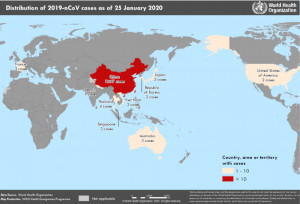
In the following month of February, a few new things about the coronavirus entered the discussion. The virus was being referred to as SARS-CoV-2. On February 11, 2020, the World Health Organization officially announced that the disease resulting from this novel coronavirus discovered in 2019 would be called COVID-19. It may have a name, but it still wasn't a full-blown health crisis in the public's minds. If anything, the main topics about COVID-19 at the time were testing and quarantining. This new viral illness still looked similar to influenza, at least to many of us.
So, for a while, I went on with my life. On February 2, 2020, the Kansas City Chiefs beat the San Francisco 49ers in Super Bowl LIV. On February 10, 2020, the Korean film
Parasite won the Academy Award for Best Picture. Having seen the film a few weeks before, I was practically ecstatic when Jane Fonda announced that film as the big winner of the 2020 Oscars. As for other movies I saw, I watched
1917,
The Call of the Wild, and
Sonic the Hedgehog. I even continued hanging out with friends, with the news of COVID-19 way in the back of my mind.

If there was anything that would be a bad omen for 2020, it wasn't related to COVID-19. It was another tragedy: the death of basketball superstar Kobe Bryant on January 26, 2020. The news of him dying in a helicopter crash, along with his 13-year-old daughter Gianna, six other passengers, and the pilot, sent shockwaves all around. It wasn't just limited to the NBA or his team, the Los Angeles Lakers. The whole world was in mourning. Little did we know that the worst was yet to come.
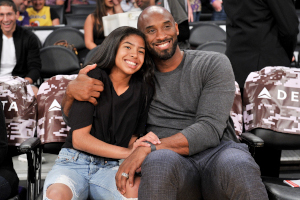
March 2020 to April 2020
Shelter in Place!
The month of March, in what was supposed to be the special year for many people, only got weirder and weirder. This was when the World Health Organization officially declared COVID-19 to be a pandemic, after the disease appeared in many countries around the world, including the United States. By this time, the only preventive health measure that was widely talked about was thorough handwashing. It did seem somewhat farfetched that so many people could get infected from touching contaminated surfaces, so part of me wondered if there was more to COVID-19 than meets the eye. Even so, I took it seriously. When I went to the local movie theater to watch
Onward, I literally avoided touching the adjacent armrests in my seat, keeping my hands in my lap the whole time.
That would be the last movie I would see in a theater for quite some time.
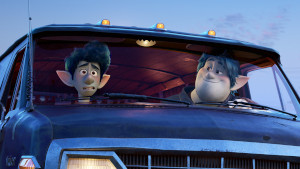
In California, there were local government actions taken left and right. Many counties imposed shelter-in-place orders, telling everyone to stay home as much as possible for a couple of weeks. School districts across the state shut down their schools temporarily. California Governor Gavin Newsom imposed a statewide ban on large gatherings until the end of the month. My planned March vacation was in serious doubt, because I imagined that even if I went, it wouldn't be the same. A small part of me still clung onto hope, even convincing myself that I would still go and enjoy whatever was available.
It didn't matter. Once my county announced its shelter-in-place order, it was time to suddenly change my life. I cancelled my March vacation, getting a refund for my hotel reservation and other stuff I paid for. The day before my county's order went into effect, my workplace instructed me to take my office computer home so that I would continue my duties from home. It was quite eerie to be lugging home employer-owned equipment. I even remember stopping at a gas station to fill up my car, all while thinking that I had only a couple of hours before the shelter-in-place order went into effect at midnight. Later, the fates of all Californians were ultimately sealed on March 19, 2020, when Governor Newsom issued Executive Order N-33-20 mandating everyone statewide to shelter in place, except where essential services like healthcare, first response, and critical government infrastructure were required.
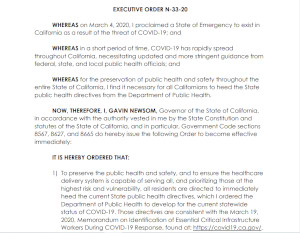
So what was it like to be sheltered in place? Well, I have to admit. It was rather relaxing. I didn't have to commute to an office. I could just shower, eat breakfast, and get to work, all under one roof. For lunch, I could just walk to my kitchen. Same for dinner. I definitely appreciated saving money from not having to pay for gas in my car. As for grocery shopping, that was an adventure. Never before had I picked up items while making sure to clean my hands with sanitizer and staying at least six feet from other people. In the very beginning, face masks were not yet mandated statewide, but I still wore a simple paper mask while shopping for groceries. Now, I didn't give up on restaurant food, because thankfully restaurants were allowed to open, but only for takeout and delivery. I certainly enjoyed that precious opportunity.
My March vacation as planned might have been cancelled, but I didn't cancel the time off I already scheduled with my employer. I just used it in a different way, by enjoying a staycation. I still had my laptop computer for Internet access and video games, plus books to read. In addition, sheltering during the COVID-19 pandemic gave me the opportunity to explore mobile device games, and I found a few I would start to play regularly. Then there was the chance to get caught up on TV shows. I used my time to watch the remaining episodes of
Miami Vice that were offered for free on the NBC website, as well as all episodes of the sitcom
Titus that comedian Christopher Titus uploaded to his YouTube channel as a free offering for his fans during the pandemic.
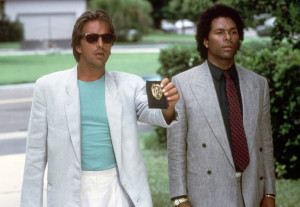
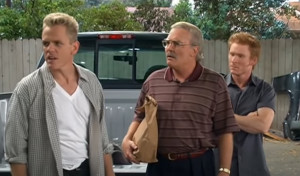
Around this time, the state of California had begun following a roadmap to get its economy back up and running in a safe manner. The idea was for the state as a whole to carefully progress through four stages of applying COVID-19 precautions to different sectors of the economy and reopening them once the precautions are in place:
- Stage 1: Safety and Preparedness - Precautions for essential workers
- Stage 2: Lower Risk Workplaces - Precautions for certain sectors like retail, offices, and manufacturing
- Stage 3: High Risk Workplaces - Precautions for nail salons, churches, entertainment venues like movie theaters
- Stage 4: End of Stay-At-Home Order - Precautions for highest-risk settings like concerts and convention centers
While sheltered at home, I would often catch the local news during lunch to watch Governor Newsom's press conferences with updates about managing the COVID-19 crisis. The same questions kept nagging me. When will we get back to normal? How many more weeks do we have to keep waiting? At the time, the state of California got through Stage 1 and was entering Stage 2. I even remember the coverage of local small businesses trying to get back on track during Stage 2. However, I also recall that, even with a collective statewide effort to progress through the roadmap together, some California counties were doing worse than others in terms of the number of COVID-19 cases, such that a special county watch list was set up for them to be monitored more closely and to have additional restrictions imposed if COVID-19 cases continued to increase.
May 2020 to July 2020
More Sheltering, Masking, and Distancing (Plus Movie Streaming)
By the time May rolled around, many people got accustomed to their new normal. In California, everyone had to wear face masks even when outside, thanks to another executive order from the governor. Same for six feet of social distancing. Masking and social distancing practically became household words. When going out, cover the nose and mouth and stay far enough away from strangers. While this was never the way we lived before, I at least found these measures simple enough that I could do them over a long period of time if need be.
Unfortunately, not everyone was that patient. When Memorial Day weekend came in late May, I found myself disgusted by news footage of people crowding on beaches, because they were tired of sheltering from COVID-19 and/or thought the virus was disappearing. It was happening in several states, not just California but also others like Florida. And sure enough, it happened. COVID-19 cases in California went up and up, as shown in the below graph from the Centers for Disease Control and Prevention (CDC). Hospitalizations and deaths showed parallel increases. So much for the four-stage roadmap.
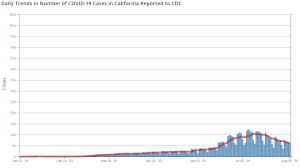
The reality pretty much set in. We were going to maintain our precautions for quite some time. That meant my stay-at-home life would have to continue. Hey, at least that meant more movies to watch. The months of June and July were when I took the opportunity to watch two documentary films, both related to politics. One was
The Brainwashing of My Dad, about a man (pictured below) undergoing a transformation as he consumed news from conservative media. The other was
Unfit, about the dangerous mental state of President Donald Trump. Aside from that, I finally got to watch the Disney animated film
The Princess and the Frog (pictured below), something I had wanted to watch for years.

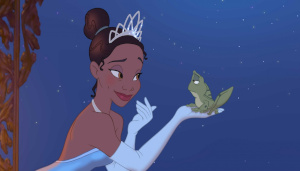
If you think Memorial Day weekend was bad with COVID-19 superspreaders, look at other major events in June and July that involved crowds, namely the nationwide protests against police in response to George Floyd's death, along with President Trump's campaign rally in Tulsa, Oklahoma, that clearly had inadequate masking and social distancing. But hey, at least people around me in California overall took COVID-19 precautions more seriously. That was why I could feel comfortable visiting local parks and going to retail stores while masked and distanced from others.
Speaking of which, you know what I bought during my little retail therapy trip? The Star Wars Skywalker Saga collection, a box set containing all nine episodic Star Wars movies, from
The Phantom Menace to
The Rise of Skywalker, on Blu-ray. In fact, the discs are nicely kept in a book containing Star Wars art and photos.

Before I forget, I bought a new laptop computer around this time. Specifically, a high-end gaming laptop that I was willing to spend a lot of money for. And yes, because of the pandemic, I ordered it online and had it shipped to my home.
August 2020 to October 2020
Waiting for Freedom, Even a Little Bit of It
With the summer surge of COVID-19 in California, it was time for the state to take more drastic action. In late August 2020, California issued a system of county-by-county restrictions called the Blueprint for a Safer Economy. Basically, instead of statewide orders plus additional measures applied to certain counties, all 58 counties in the state were subject to the same roadmap, but progressed at their own individual pace. At its core, the Blueprint assigned to each county one of four color-coded tiers according to the county's case rate per 100,000 people and the test positivity rate, both averaged over 7 days:
- Tier 1 - Widespread (Purple): Greater than 7 cases per 100,000 and test positivity rate greater than 8%
- Tier 2 - Substantial (Red): 4 to 7 cases per 100,000 and test positivity rate of 5% to 8%
- Tier 3 - Moderate (Orange): 1 to 3.9 cases per 100,000 and test positivity rate of 2% to 4.9%
- Tier 4 - Minimal (Yellow): Less than 1 case per 100,000 and test positivity rate of less than 2%
Should a county have the case rate fall in one tier but the test positivity rate fall in another, the stricter tier is the assigned one. The worse the numbers, the more restrictions imposed. For example, in the Purple tier, pretty much the only businesses that could open were essential ones, like grocery stores, gas stations, and medical facilities. The Red tier allowed certain businesses to open at 25% capacity, which is rather small. The Orange tier allowed further increases of indoor capacity, from 25% to 50% or from 0% to 25% depending on the type of business. The Yellow tier allowed mostly 50% indoor capacity. That should give you an idea of how this works if you're not from California. As for where the state was when the Blueprint was officially implemented, nearly the entire state was in deep Purple, as shown in the map below.
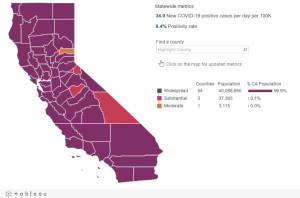
In order for a county to progress to the next less-restrictive tier, it must lower both its case rate per 100,000 and its test positivity rate to fall in the ranges for the next tier. Furthermore, the county must hold the improved numbers for two consecutive weeks before it could officially move on to the next tier, and can only progress one tier at a time, not jump two or three tiers. Should the numbers worsen and fall in a more restrictive tier, the county would immediately go backward. The color-coded county map would get updated each week on Tuesday.
Overall, it's a lot to handle. Imagine being sheltered at home, doing one's part to prevent spread of the novel coronavirus, checking the COVID-19 numbers in one's own county each day, and seeing the weekly updates to the state Blueprint map. I wanted to go out again to a movie theater or dine in at a restaurant, but I would have to wait for my county to go from Purple to Red. That meant waiting many weeks for the county's COVID-19 numbers to gradually decrease until it met the Red tier criteria, then praying that the Red criteria were met for a second consecutive week before the county could officially go Red and things could open up minimally.
It was such a long wait that I just focused on my indoor hobbies, like watching new movies. Over a three-month period, I got to do a variety of things. One of them was watching three things via online streaming: the old Harrison Ford movie
Patriot Games that was available for free on IMDb TV, the Showtime miniseries
The Comey Rule, and the comedy film
Borat Subsequent Moviefilm on Amazon Prime. The year 2020 may have been a real lackluster year for movies released in theaters and for new movies to be produced, but at least the options for streaming were still numerous.
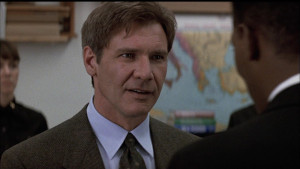
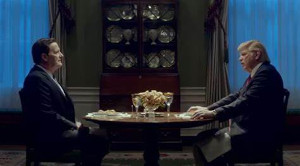
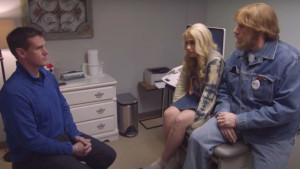
While I didn't mind seeing random movies online, there was still one movie I would have to put off for a long time: the new James Bond movie No Time to Die. It's bad enough that, due to production-related delays, its original release date got moved from November 2019 to February 2020 and then April 2020. But because of the COVID-19 pandemic, it got moved again to November 2020. Then, with the summer COVID-19 surge in the United States and presumably in some other countries as well, the movie got delayed once more, pushed back to April 2021.

November 2020 to December 2020
So Much for the Holidays
After a long wait, California updated the color-coded county-by-county COVID-19 restriction map on November 10, 2020, shown below. As you can see, many counties had gone from the Purple tier to the Red tier. I was happy with the progress, even if it took a darn long time for us to get there.
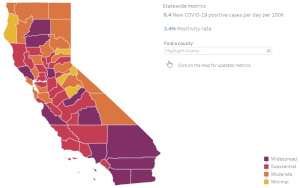
Like many people, I lived in a county that was in a non-Purple tier. Even better was that adjacent counties also got out of the Purple tier. Given that I wanted so badly to go back to a movie theater, I checked around to see which theaters reopened and what movies were playing. At the time, the only movie I wanted to see was
Tenet. I called a friend, who was available to come out to the movies with me, and she also was looking forward to the opportunity to get out again, even if things would be pretty quiet. So I bought two tickets online in advance for us to watch Tenet on Sunday, November 15, 2021.
Let me tell you. It felt pretty good to get out that day. City street traffic was lighter than usual, but that was a plus. So was the availability of so many spaces in the parking garage I went to. Then there was the outdoor dining. Before my friend arrived for the early afternoon showing of Tenet, I grabbed lunch a few blocks from the theater. A couple of restaurants and cafes were open, and many had outdoor dining tables and chairs. Naturally, I ordered takeout at one place and ate my meal outside, enjoying the nice weather along with my food. Then I headed to the theater where my friend arrived.
I saw only about seven other theater patrons in the building, and I encountered only about three theater staff people on the way to our reserved seats. My friend and I were among the brave ones who got out wearing face masks, all to reexperience being in a movie theater. You know what's funny? She and I were the only people in the auditorium watching Tenet, so this was one of the few times in my life where I talked out loud in a theater without offending anyone. Other than that, I enjoyed the movie.
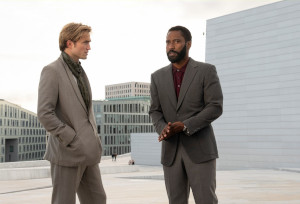

It was a good thing we saw the movie in time, too. Believe it or not, I was following the local news the next day, and I got word that the Blueprint for a Safer Economy map would be updated that day, Monday, instead of the usual Tuesday. The news wasn't good. Cases were going up so much that many counties were reverting back to Purple, including the one where my friend and I watched Tenet. I even called her to pass that along, and she also expressed amazement at our timing with the theater visit. So anyway, here's how bad the map suddenly got:
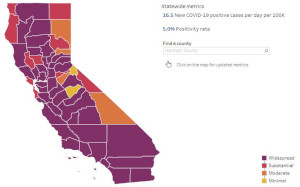
You know what it was, most likely? Early holiday travel. Thanksgiving was almost here, and people were already scrambling to head out early to see their families, even during a pandemic. Despite warnings against travel, along with recommendations to skip holiday gatherings just for this year in order to stay alive for the years to come, many people didn't want to give up their holiday traditions. And even after Thanksgiving passed, people still insisted on traveling for Christmas. The result of this was the CDC's graph of daily cases for California, shown below:
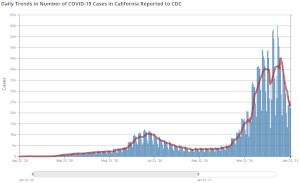
It's really bad, as you can see. That prompted the state of California to go even further with COVID-19 restrictions, with the Regional Stay-at-Home Order implemented in the middle of December 2020. In place of the county-by-county map, Californians were subject to a new region-by-region map that had temporarily overridden the county-by-county map. With the new map, counties were lumped together into five regions: Northern California, Greater Sacramento, Bay Area, San Joaquin Valley, and Southern California. If the percent of ICU beds throughout a region was less than 15%, many businesses had to close while certain others could open with modifications. Once it was determined that the region's four-week projections for ICU bed availability were above 15%, the Regional Stay-at-Home Order could end for that region and all counties within could return to the county-by-county Blueprint for a Safer Economy roadmap.
All I can say is that when that regional system was put in place, I just acted like it was March 2020 all over again. I stayed in as much as possible and made the best out of my indoor life.
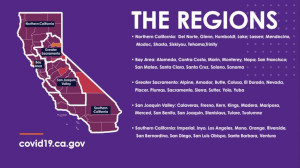
With the end of 2020 approaching, was there really anything to celebrate? I supposed there was one. In the middle of December, the U.S. Food and Drug Administration (FDA) granted Emergency Use Authorization to two COVID-19 vaccines, one made by Pfizer and one from Moderna. Part of me felt good, because I thought a vaccine for COVID-19 would take a much longer time to become available. Another part of me wondered if this vaccine would be effective and safe. Also, some people had questions about whether we could trust this vaccine the same way as if the vaccine were to receive standard FDA approval following a much more thorough review of more extensive data.
Aside from that, there's much reason to look at 2020 as the year we all want to forget. We endured the COVID-19 pandemic, social unrest in response to police brutality, and a hotly contested U.S. presidential election. Then there were the celebrity deaths, including Max von Sydow, Olivia de Havilland, Terry Jones of Monty Python, Kenny Rogers, Dawn Wells of
Gilligan's Island fame (and she was a COVID-19 casualty, sadly), Carl Reiner, and Eddie Van Halen. There was also the passing of a political star: U.S. Supreme Court Justice Ruth Bader Ginsburg. For me, the biggest celebrity deaths were of Sean Connery, Alex Trebek, and Chadwick Boseman. May all of them rest in peace. (And may 2020 be forever behind us, too.)
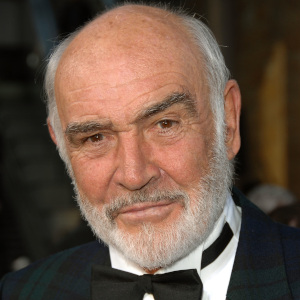
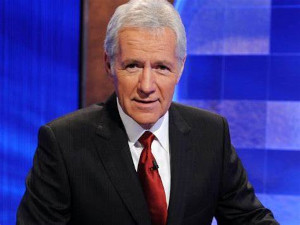
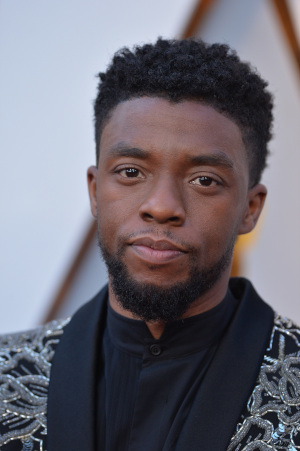
January 2021 to February 2021
Happy New Year?
While there were still New Year's Eve celebrations around the world, they were much more low-key than usual, such that I barely paid attention to any of it. If anything, 2021 already seemed to be off to a bad start. For me, it was because of what happened on January 6, 2021: a mob of angry people storming the U.S. Capitol in hopes of disrupting the Electoral College vote count, preventing the certification of President-elect Joe Biden, and keeping President Donald Trump in power. For many reasons that I'd rather not get into, this is perhaps the most sickening thing that I have ever witnessed happening in the United States of America. But enough about that.
There was also the news that, with the fall 2020 COVID-19 surge, the Bond movie No Time to Die got its release date pushed back yet again, to October 2021. I hoped that it would be the last time the 25th official Bond movie would be delayed.

Ultimately, I did have one New Year's resolution. Given that monthly subscription prices for various streaming platforms were no more expensive than a single ticket at a movie theater, I decided that I would watch more stuff on paid streaming platforms. I figured that, on whatever platform I felt like, I would pay for one month, then watch at least three or four movies during that period, as if I were watching that many movies for the price of one. With that, I signed up for Disney+ and watched four movies: the live-action remake of
Mulan, the Pixar animated film
Soul,
Frozen, and
Frozen II.



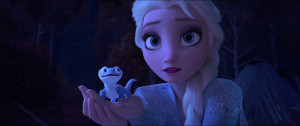
Soon, there were two reasons to be a little more optimistic about the COVID-19 pandemic. First, the FDA granted Emergency Use Authorization to a third COVID-19 vaccine, developed by Johnson & Johnson. It's a vaccine that required only one shot, instead of two like with the Pfizer and Moderna vaccines. Second, there was enough improvement in the COVID-19 numbers in California that all five regions no longer required the regional restrictions, such that all counties returned to the county-by-county Blueprint. It was time once again to watch and pray for progress towards the least restrictive Yellow tier.
Meanwhile, the Golden Globes award ceremony took place, done virtually rather than in person. I did not tune in, though it was cool that Borat Subsequent Moviefilm won two Golden Globes for Best Motion Picture, Musical or Comedy and for Best Actor, Motion Picture, Musical or Comedy (Sacha Baron Cohen). I also became aware of criticisms about the lack of racial diversity among members of the Hollywood Foreign Press Association. Certainly, that is something that should be fixed.
March 2021 to May 2021
Getting Out With Less Fear
I still wanted to go out to the movies, but theaters were closed. That included one theater that I would often visit with another friend of mine. Just for fun, I took a picture of that closed theater and texted it to him, to which he responded that things looked like a ghost town. Around that time, I realized that the restrictions on movie theaters were for indoor theaters, and that only outdoor viewing of movies was allowed. That prompted me to look into a movie-watching option I had not experienced in years: the drive-in movie theater.
When I was a kid, there were plenty of drive-in movie theaters. Many of them offered free admission for kids under 12, so my parents took me to drive-in movies on several occasions. Sometimes I loved the movie. Other times, I got bored and went to sleep while they enjoyed the film. They're interesting memories, I must say. I looked back on them as I got ready to watch
Wonder Woman 1984 in a drive-in in March 2021. Man, it was fun to bring my own dinner and enjoy it in my car while the movie was playing on a big screen and the film's audio was transmitted through my car radio.
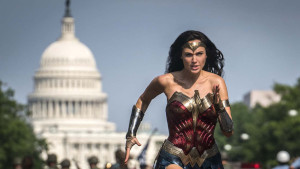
Another movie I saw in the same month was
Raya and the Last Dragon. This was the first time in many months that I watched a movie in an indoor theater, thanks to my county allowing movie theaters to reopen with limited capacity. Even better was that I had gotten by COVID-19 vaccinated by this time, so that I felt safe even while complying with the order to wear masks in the theater. All I can say is that it was great to be back.

This is a good time to bring up something that I, along with many others, had noticed for a while. Plenty of movies during the COVID-19 pandemic were being released simultaneously in theaters as well as on streaming platforms for a fee. It made sense, given that some people still did not want to venture out of their homes because of risks with the virus. I will not be surprised if this practice continues after the pandemic ends. As more people appreciate ways to enjoy movies at home, whether with just their computers, phones, and tablets, or with home theater setups, movie studios could cater to these folks by streaming the movie on release while still having it in theaters for the old-timers.
The month of April brought some unexpected good news about COVID-19. First, in California, Governor Newsom surprised the state by announcing that all businesses in California would fully reopen starting June 15. This was based on data projecting that, with ongoing vaccination efforts, the virus could be under sufficient control by then. Also, sometime during the same month, it was reported that half of all American adults nationwide had received at least one dose of a COVID-19 vaccine. That's an important milestone for sure. All of this was occurring as case numbers continued to decline in California, as shown below.
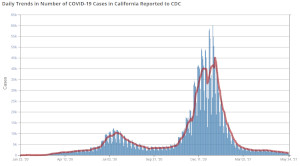
And what better way to celebrate the imminent start of summer and full reopening of California than with another trip to the movie theater? In late May, I finally saw the 80s movie
Top Gun after all this time. Better late than never, I suppose.

June 2021 to September 2021
California Reopens, Delta Variant Surges
I was so excited to get out again as a fully-vaccinated individual that I did plenty of things outside the home, all while masked and socially distanced. In terms of movies, another one I saw in early June was the new
Mortal Kombat movie, which was interesting.


At last, June 15 arrived. California fully reopened as planned. That's not to say there were no COVID-19 restrictions imposed, but they were noticeably less. For one thing, there were no more social distancing requirements and business capacity limits. Plus, the color-coded county-by-county Blueprint for a Safer Economy map was discontinued, after a little more than nine months of use. There were really just two COVID-19 restrictions for California. One was the requirement of masks in certain settings, like public transportation, healthcare, schools, child daycare centers, community centers, and prisons. The other was related to proof of vaccination before attending large crowded events, like concerts and conventions. Vaccination was required for indoor events with more than 5,000 people and strongly recommended for outdoor events with more than 10,000 people. Otherwise, all other businesses could require masks if they individually chose to.
With these conditions, I would get out there safely and feel good, while still carrying a mask in my pocket just in case I encountered a place that required face masks. To illustrate how much progress California made, below is the final Blueprint map released on June 15. Nearly every county was Yellow or Orange, only one was Red, and not a single county was Purple.
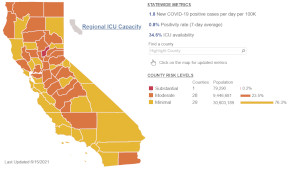
Mind you, I didn't actually go out on June 15 or even the couple of days after. Eventually, I headed out to my local movie theater to watch the musical film
In the Heights, which to me was really the perfect way to celebrate getting out again. In fact, I remember that, before the feature presentation, there was a public service announcement shown that told us to get the COVID-19 vaccine if we haven't done so already. I thought that was a nice touch.
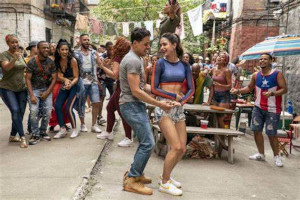

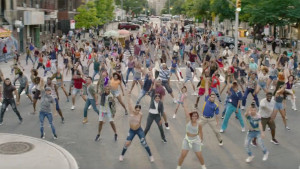
That said, COVID-19 surged again, this time with the Delta variant that was much more transmissible than earlier variants of the virus. The good news, at least for the time being, was that this didn't look like it would be a repeat of the really bad surge of the fall of 2020. Many people were fully vaccinated, and reports suggested that COVID-19 vaccines provided good protection against the Delta variant. Really, this was, as described by Dr. Rochelle Walensky the CDC Director, a "pandemic of the unvaccinated." The problem was that there were still lots of unvaccinated Americans, and the fear was that if the Delta variant could replicate often enough, it would produce more variants, with at least one that could evade the vaccines and put the whole country back to square one.
With news like this, I tried hard to maintain optimism. Yes, there were increases in cases, hospitalizations, and deaths, even in certain parts of California, but surely they would get past their peaks soon. I was prepared to still carry a mask with me when going outside, and to comply with new restrictions should California clamp down on COVID-19 once again (though part of me believed it wouldn't happen, given the reopening). After all, I'd been through it before already. And I believed the James Bond movie No Time to Die would still be played in theaters in October as scheduled.
In the meantime, I kept myself sane with the final season of
Bosch on my computer; the movies
Black Widow,
Space Jam: A New Legacy,
Free Guy, and
Shang-Chi and the Legend of the Ten Rings at local theaters; and other hobbies. I also began playing a new video game on my PC, Red Dead Redemption 2, that I immediately enjoyed from the start.


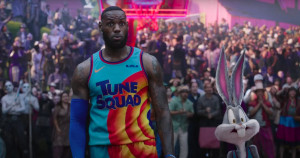
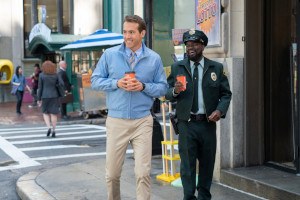
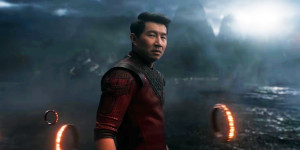
October 2021 to December 2021
No Time to Die, as Delta Continues and Omicron Spreads Really Fast
As October 2021 started, I was 100% confident that there would be no more delays for No Time to Die. That turned into excitement and anticipation. Well, not exactly at huge levels, but they were significant nonetheless. It was, after all, a symbolic milestone of the progress made with the pandemic. Whereas 2020 was marked with movie theater openings that were rare and temporary, 2021 was the year of COVID-19 vaccination that made it possible to repoen movie theaters consistently, even if attendance would still be lower than pre-pandemic levels because of personal fears of COVID-19 or local public health restrictions. In a way, No Time to Die wasn't just the title of a Bond movie. It was also a statement that we would continue to live, even in a pandemic.
Sitting in the theater while wearing a face mask felt no different from past moviegoing experiences, other than the feeling of gratefulness that came with movie theaters making a comeback. Once No Time to Die started playing on the screen, all else was forgotten. I just focused on this movie that I had been waiting over one-and-a-half years for. I enjoyed all of it: the story, the performances, and the action, not to mention the emotional conclusion.
No Time to Die was a phenomenal Bond movie.
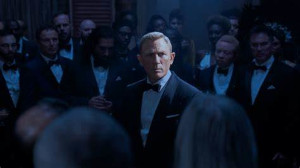
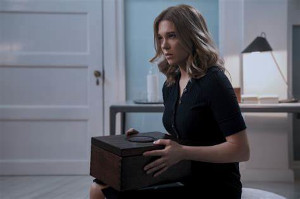
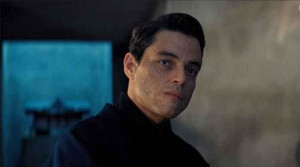
At this point, the COVID-19 pandemic became much less of a concern for me. I was fully vaccinated and did not fear the Delta variant one bit. That's true for a lot of other people, I'm sure. I even paid less attention to the latest COVID-19 statistics in the United States, because the vaccine eased all fears of infection, even with no social distancing. Did I completely ignore any signs the pandemic was ongoing? Of course not. I was still working from home. I still wore a face mask everywhere I went in public. I still had to show proof of vaccination for public events with large crowds. But that's nothing compared to getting most of my life back. At this time, I even got to see friends again after not seeing them for over 18 months.
My comfort with pandemic life kept me coming back to the movie theater as in the preceding months. I made a determination to visit the movie theater each weekend if possible. I got to see plenty of movies in November and December:
Eternals,
Ghostbusters: Afterlife,
House of Gucci (on the same day I watched Ghostbusters: Afterlife), the new
West Side Story,
Spider-Man: No Way Home, and
The King's Man (on Christmas Day, believe it or not). Speaking of which, I heard that Spider-Man: No Way Home crossed the $800 billion mark in box office gross, a sign that the movie theater business was definitely roaring back to life even in a pandemic.
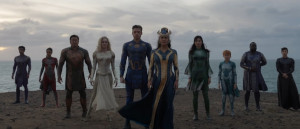
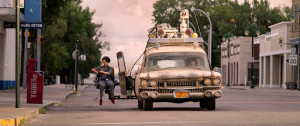

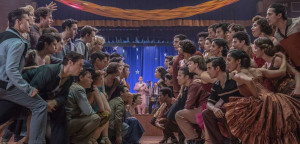


But as December began winding down toward the Christmas holiday, the world had to process another major development with COVID-19: the emergence of the Omicron variant, which could duplicate and spread even more quickly than the Delta variant that was already the most contagious strain to date. The Omicron variant became the dominant strain in the U.S. and the world in just a matter of days. My reaction was like a lot of people's: "Oh great, are we screwed now?" Thankfully, there were still some good news associated with it. Although the Omicron variant could evade vaccines to a certain extent, such that percent efficacy dropped, optimal protection could still be achieved if full vaccination was followed by a booster shot. I made an appointment to get a booster shot not too long after the emergence of Omicron. There was also the possibility that this variant wasn't as severe as past variants, which gave me some hope.
With that, I wrapped up 2021 with feelings of optimism. I predicted that the combination of ongoing vaccination efforts and new strains of COVID-19 being milder while spreading more easily would make 2022 better than 2021. I'm not saying the COVID-19 pandemic would not throw us any more challenges, because COVID-19 cases among mainly unvaccinated individuals could still strain hospital systems, cutting off needed care for non-COVID patients. But as the old saying goes, things may have to get worse before they get better.
January 2022 to February 2022
The Omicron Peak to Start the New Year
I could easily say one thing about 2022: it's no 2020. My feelings between the two were practically night and day, with 2020 being the feel-bad year because COVID-19 vaccinations were not yet available and 2022 being the feel-good year because of those vaccinations. I was finally vaccinated with two Pfizer vaccine doses by this time, and I had no fears of the novel coronavirus since, even if I didn't get a booster shot yet. That would change real quick. I made an appointment with a pharmacy to receive one dose of the Moderna vaccine as a booster. Unlike my previous two injections, I did end up having chills from the booster shot for two days. Then I felt totally fine again.
After nearly two years, wearing a face mask in public became so routine that it practically became insignificant. It didn't stop me from doing the things I enjoy. Because of my status of being both vaccinated and boosted, I no longer worried about social distancing. Part of me felt that I was already doing my part with vaccines and masks. Another part of me felt that everyone else who was eligible to get vaccinated should do so. Unlike before, I barely paid attention to the rise, plateau, and fall of COVID-19 cases, hospitalizations, and deaths related to the surge of the Omicron variant of the virus over two months. Same for the FDA's authorization of the Pfizer vaccine for children as young as five years of age, as well as the state of California issuing a universal indoor masking mandate effective for one month. Even the fact that California's Omicron peak in cases overshadowed its Delta peak, shown below, was barely on my radar.
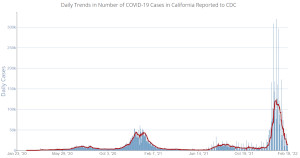
So yeah, life at this point in the pandemic felt close to pre-pandemic. At least there was no chance that movie theaters would have to shut down again. I didn't see any movies in January, but I did take the time to binge-watch the two live-action Star Wars series on Disney+: The Mandalorian and The Book of Boba Fett. In February, I saw the movies
Moonfall and
Jackass Forever. In fact, I watched Moonfall in the same movie theater where I saw Tenet in the fall of 2020 shortly before that theater had to shut down again. I also went with the same friend who accompanied me at that time. As we entered the theater auditorium for Moonfall, we commented on how this felt way more free than the last time, and it was a sign that life was making a comeback.
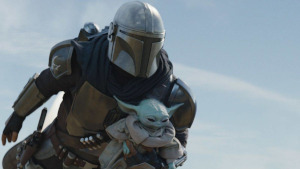
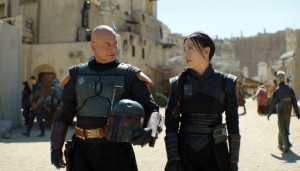
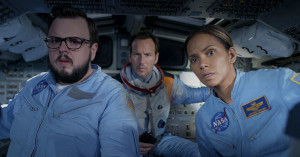
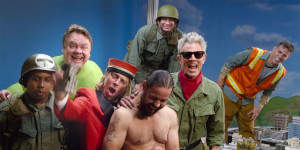
Going back to COVID-19, the temporary one-month statewide mask mandate ended, so that we went back to the mask mandate for specific settings. Governor Newsom made another announcement in mid-February: California would go from responding to COVID-19 as a life-and-death medical emergency to living with COVID-19 while having multiple prepared steps of action in place. Known as the California SMARTER Plan, it would involve seven components, one for each letter of the SMARTER acronym:
- Shots (vaccines)
- Masks (face masks)
- Awareness (staying on top of COVID-19's evolution)
- Readiness (providing resources for quick response by healthcare facilities)
- Testing (COVID-19 tests, including polymerase chain reaction tests and antigen tests)
- Education (keeping California schools open)
- Rx (treatments)
All in all, the SMARTER Plan was a significant step forward, in line with many people's waning fears of the virus and their desire to move on.
March 2022 to April 2022
Pandemic? What Pandemic?
As long as I was fully vaccinated and boosted, I was free. I had no worries about getting sick from COVID-19. I knew that I could catch the virus because the latest variant could reproduce super quickly. But at this point in the pandemic, the objective was no longer to avoid getting the virus in the first place. It was simply to avoid severe illness from it, putting me in the hospital or killing me. The availability of COVID-19 vaccines made all the difference.
That said, I experienced something else stemming from the pandemic: supply chain disruptions. Before the pandemic, I had plans to buy a new hybrid vehicle in the year 2020, which was supposed to be a special year. After putting that off for two years, I went to a few local car dealerships to ask about the car model I wanted. To my dismay, none of it was available. Due to disruptions with every single part of the supply chain, from the lack of semiconductors to bottlenecks at ports, there would be no vehicles of my preferred model for many months, maybe a few years. I had forgotten that disruptions of employment during the pandemic did lead a lot of people to rethink their career paths, with many deciding to change jobs and not returning to what they had done before. Guess I would have to keep driving my old car for quite some time.
Going back to the pandemic, I had more good experiences with going back to movie theaters. Once again, it was great to be back and I had absolutely no worries about theaters being reclosed again. When I watched
The Batman, I sat between my friend and a total stranger, with no empty seats in between. I had no concerns about social distancing. Even cooler was when I watched
Sonic the Hedgehog 2. One of the last movies I had seen before the business shutdowns was the first Sonic the Hedgehog movie. To be able to see the sequel at the other side of the pandemic was a significant step forward.
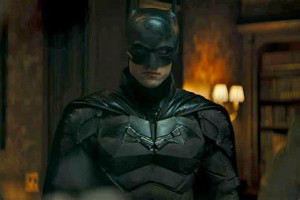

Meanwhile, you remember the vacation I had planned two years earlier but had to cancel? Well, with the pandemic under much better control, I did finally go on the vacation I had wanted. I got to do all of the things I wanted to do two years ago. What's funny is that the hotel I stayed in was the same one I had booked a room for before cancelling the reservation. Also, with the state of the COVID-19 pandemic in California, the only place I ran into a mask mandate was the hotel, which required masking for common areas such as the lobby. Otherwise, any mention of face masks was presented as recommendations, not requirements. But even if I had run into more mask mandates, I would still comply with them and I would still have as great of a time as I did.
May 2022 to June 2022
Arrival of the Sixth Wave, Practically Out of Sight and Out of Mind
At this point in time, I could recall five COVID-19 surges in California: the days following Memorial Day weekend 2020, the summer of 2020, the holiday season of 2020, the Delta surge in mid-2021, and the Omicron surge after that. I had heard brief reports of a sixth wave in the state, but honestly, I was tuning out. It's not that I lost patience like some people early on. It's that I no longer feared the virus given that I was fully vaccinated and boosted, especially as I had no bad experiences with COVID-19 in relation to the vacation the month before. Another sign of normalcy really making a comeback: watching an NBA playoff basketball game on TV, where fans filled the arena just like pre-pandemic. Even the news of monkeypox infecting a couple of Americans didn't sway me. Of course, that disease spreads through direct contact, not as quickly as a respiratory virus.
That being said, I did get mildly ill close to Memorial Day weekend, experiencing tolerable fever, chills, and runny nose. It felt just like a cold. By this time, I did have a home COVID-19 test kit that I received for free in the mail, courtesy of the federal government. I did the easy-to-perform test, and sure enough, I tested positive for COVID-19. It didn't shock me at all knowing that the virus was practically everywhere. (In fact, around this time, even Governor Newsom tested positive for COVID-19 with mild symptoms, prompting him to work in isolation for a few days.) Plus, being fully vaccinated and boosted prevented me from suffering severely from the virus. It's totally better to get the virus with vaccines available than before the first vaccine ever got released. By taking the right steps, we could get through this pandemic.
Throughout this commentary, I have been noting which movies I had seen in order to show how much I tried to enjoy the movies during the pandemic. At this point, I'm not going to list every movie and TV show I watch, because things had gotten feeling close to normal. That said, here's a quick rundown of what I'd watched in May and June of 2022:
Everything Everywhere All at Once,
Doctor Strange in the Multiverse of Madness, and
Top Gun: Maverick, plus episodes of Bosch: Legacy on Amazon Freevee and of
WandaVision and Obi-Wan Kenobi on Disney+.
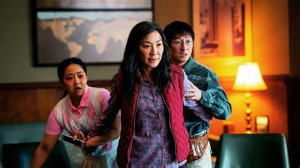
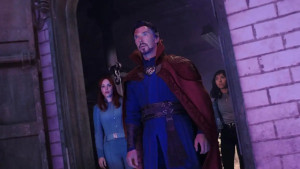

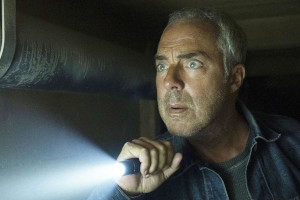
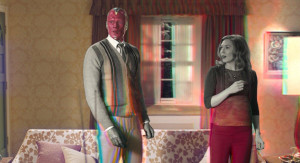
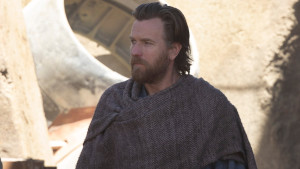
On top of that, I finally wrapped up the video game
Red Dead Redemption 2, after playing it for almost a whole year. Read my review of the game to see my thoughts on it. In a word, it's just an incredible piece of work.
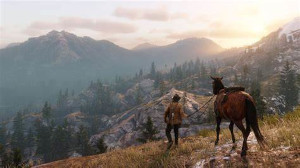
Lastly, there was one big piece of good news with the pandemic: FDA emergency authorization of the Pfizer and Moderna COVID-19 vaccines for children at least six months of age. With this and prior authorizations of those vaccines for children ages five and up and for all adults, nearly the entire population in the United States was eligible to get vaccinated against COVID-19. I hoped that would decrease the COVID-19 caseload.
July 2022 to December 2022
The Pandemic Is Not Officially Over, But It Is For Me
It's not unusual for a pandemic to last two years or more, but that's still a long time for anyone. It's a large chunk of life already gone by. This is why people, even those who aren't anti-science, may long for getting back to normal as soon as possible. I admit that I was one of them in mid-2022. Also, understand that goals related to COVID-19 shifted. In the beginning, it was ideal for people to quarantine, prevent the spread of the virus, and let it die out. Since that didn't happen, the next priority was to take precautions and survive until vaccines came along. Ever since getting my three shots, I'd had much greater peace of mind. At this point, the goal should simply be to stay fully protected, given that COVID-19 will indeed remain with us.
Hence, during the second half of 2022, I got back to living my life. I was still working remotely from home, which I absolutely loved and would never abandon if given the option permanently. Time spent on commuting to and from work became extra time for leisure. I continued to watch movies in theaters unmasked without worry. The same went for various hobbies in public away from home. I spent time on Disney+ watching the Star Wars series Andor and various Marvel Cinematic Universe movies and shows that I previously skipped. I even traveled a few times, including once by plane, and never gave COVID-19 any second thought. Again, the ultimate goal was to stay alive and healthy by whatever means. If the virus won't go away but there are effective options for protection, why not take them?
On that note, I got my second booster shot in the fall of 2022. It was the Moderna booster updated for additional protection against the Omicron BA.5 variant of COVID. It was nice to get it. I did have to endure some symptoms like chills as a result of my immune system responding to the shot, but once that passed, I felt good again. Later on, I did have an upper respiratory infection mainly involving a running nose. Home COVID-19 testing came up negative, though I wasn't sure if it's because it wasn't COVID or because the test was no longer effective, given that its expiration date was a few weeks back. In any event, it didn't make me pay more attention to COVID-related updates, like new COVID variants and the simultaneous presence of COVID-19, flu, and respiratory syncytial virus.
On New Year's Eve, I took a quick glimpse into the news of celebrations around the world. For example, I heard that the city of New York was going to have a Times Square crowd like before the pandemic, as more people were ready to get out again. Just like me. This is also a good time for me to mention that this lengthy commentary on COVID-19, which I had been adding to from time to time, will soon be coming to an end.
January 2023 to February 2023
What the COVID-19 Pandemic Has Shown Us
Even after the first two months of 2023, there is barely anything more for me to say about COVID-19, movies, and living life. I do, however, want to take this opportunity to go over the ways in which the world has changed as a result of the pandemic, for better or for worse. The following is my list of the biggest things I've seen with the pandemic.
* WORKING FROM HOME: Even as the Internet made remote communication and work possible for the last two decades, the idea of working remotely from home or anywhere else was not a mainstream idea. It would take the extraordinary circumstance of a pandemic to force office workers into this situation. While some people may miss face-to-face interactions with people, others may welcome the savings and time from the elimination of a commute, not to mention the comfort of a familiar environment that can maintain or even boost productivity. If anything, those folks want this to be the new normal. I know. I'm one of them.
* VIRTUAL MEETING PLATFORMS: Obviously, working from home means it is necessary to communicate using virtual meeting platforms, such as Zoom. But work isn't the only context where virtual meetings have become a big thing. Social gatherings and other types of fun events may also be done virtually, either entirely or as a supplement to an in-person gathering. You can definitely see this on Meetup.com, which started providing the option of posting a virtual meeting link in addition to posting the details of a physical location for an event.

* ESSENTIAL WORKERS: Before the pandemic, a lot of people never really took the time to understand and appreciate the value of everyday workers, particularly those in industries that we take for granted. Once COVID-19 disrupting supply chains made us nervous about the availability of groceries, medical supplies, and healthcare services, many people started to see how essential these workers are, especially if they have no choice but to go to work with the risk of contracting COVID-19. Going forward, we should thank any worker for providing us with whatever it is we need or enjoy.
* ANTI-SCIENCE SENTIMENT: Unfortunately, one of the most striking things about the pandemic is the scale to which people ended up distrusting experts in science and medicine while consuming and believing conspiracy theories. Many such people have died from COVID-19 and probably would've survived if they took precautions more seriously. The pandemic revealed to us the many anti-science individuals living among us, and it is something that we will have to deal with for quite some time.
* MOVIE STREAMING: With movie theaters closed during the pandemic, people wanting to watch movies were limited to rewatching whatever movies they already own or turning to movie streaming platforms. It is no surprise that streaming entertainment got a significant boost in 2020 and onward. Also, major awards ceremonies like the Golden Globes gave notably more recognition to works produced for streaming than those for theaters and traditional television. I think it is safe to say that streaming entertainment is as big of a player as entertainment shown in theaters and on broadcast and cable television. I know this as a subscriber of Disney+.
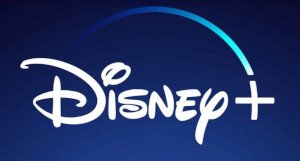
* FOOD PICK-UP AND DELIVERY: The restaurant industry was also shaken up by the COVID-19 pandemic. If in-person indoor dining was not allowed under health guidelines, restaurants had to resort to pick-up and/or delivery as options to keep their businesses afloat. It does seem that if such options were not provided before, they are continuing to be offered even with the return of indoor dining. Also, meal delivery services like Grubhub and Uber Eats found opportunities during the pandemic to grow, another example of circumstances leading to ingenuity.
* OUTDOOR DINING: While I'm on the subject of restaurants, let's appreciate outdoor dining. When it became clear that the COVID-19 virus could potentially disperse and disappear with the turbulent air of an outdoor environment, people welcome the option of eating at restaurants right outside their doors. Parking lots and curbside parking spaces became tented spaces for people to eat in person. While some restaurants are fully returning to indoor dining, others may still maintain their outdoor dining options. I would love to see more of the latter, especially on segments of city streets that have been converted into pedestrian-only zones.
* OTHER SIMPLE PLEASURES IN LIFE: The pandemic really made people take a second look at all of their options for leisure, given that options outside the home were suddenly cut off. I have heard stories related to increased enjoyment of board games, a greater appreciation for parks and nature, and families coming closer, just to name a few examples. Really, when something threatens to take away our lives, we become more aware of how precious life is and all the things that make it worthwhile, including the simple things.
Overall, I'm feeling good about the positives and continue to keep my eye on the negatives. No matter what, the world we live in is something to enjoy and take care of. And on that note, the State of California officially ended its COVID-19 emergency declaration on February 28, 2023, after three long years.
March 2023
Final Thoughts
This commentary piece was something I never expected to write, but it's one of those times where unusual circumstances provide inspiration. Putting down my thoughts from time to time helped me cope with the pandemic and the chaos of the world. Looking back on it now, I have to say that I'm quite glad about writing all of this. It reminds me that, with resilience and patience, it is possible to get past any obstacle in life.
COVID-19 really did upend entertainment like never before, whether it's the movies or any other hobby. But it did much more than that. It changed life as we know it, at least in some noticeable ways. COVID-19 remains with us, but with the tools to protect ourselves, we can live with it and perhaps find more ways to treat it. I believe that we will be fine down the line.
With that, thanks for taking the time to read my observations and thoughts about the past three years. It's been quite a ride.
